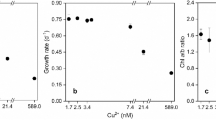Abstract
Copper uptake in the diazotrophic cyanobacteriumNostoc calcicola was found to be typically biphasic, comprising rapid binding of the cations to the cell wall (during the first 10 min) followed by the subsequent metabolism-dependent intracellular uptake for at least 1 h, with a curvilinear kinetics saturating at 40 µM (Km 25.0 µM, Vmax 3.0 nmol Cu mg−1 protein min−1). The cellular Cu uptake was light- and ATP-dependent, and the addition of 3(3,4-dichlorophenyl)-1,1-dimethylurea or exogenous ATP proved that the energy to drive Cu transport was derived mainly through PS II reactions. The application of metabolic inhibitors and uncouplers like carbonylcyanidep-nitrofluoromethoxylphenyl hydrazone, N,N′-dicyclohexycarbodiimide, azide, and p-chloromercuribenzoate revealed that -SH group(s), proton gradient across the cell membrane, and ATP hydrolysis were involved in the transmembrane movement of Cu inN. calcicola. While monothiol (2-mercaptoethanol) caused a twofold reduction in Cu uptake rate, dithiol (dithiothreitol) contributed towards a further drop in the cation uptake rate.
Similar content being viewed by others
Literature Cited
Agrawal M Jr, Kumar HD (1977) Cobalt toxicity and its possible mode of action in blue-green algaAnacystis nidulans. Beit Biol Pflanz 53:157–167
Allen MB, Arnon DJ (1955) Studies on nitrogen-fixing blue-green algae. I. Growth and nitrogen fixation byAnabaena cylindrica Lemm. Plant Physiol. 30:366–372
Brachet J (1975) The effects of some inhibitors of RNA synthesis and proteolysis on morphogenesis inAcetabularia mediterranea. Biochem Physiol Pflanz 168:493–510
Campbell PM, Smith GD (1986) Transport and accumulation of nickel ions in the cyanobacteriumAnabaena cylindrica. Arch Biochem Biophys 244:470–477
Gadd GM, Griffiths AJ (1978) Microorganisms and heavy metal toxicity. Microb Ecol 4:303–317
Gipps JF, Coller BAW (1980) Effect of physical and culture conditions on uptake of cadmium byChlorella pyrenoidosa. Aust J Mar Freshwater Res 31:747–755
Gould JM (1978) Dithiol-specific reversal of triphenyltin inhibition of CFO-catalyzed transmembrane proton transfer in chloroplasts. FEBS Lett 94:90–94
Herbert D, Phipps PJ, Strange RE (1971) Chemical analysis of microbial cells. In: Norris JR, Ribbons DW (eds) Methods in microbiology, vol VB. London and New York: Academic Press, pp 209–344
Hewitt EJ, Nicholas DJ (1963) Cations and anions: inhibitions and interactions in metabolism and in enzyme activity. In: Hochster RM, Quastel JH (eds) Metabolic inhibitors, vol II. New York and London: Academic Press, pp 311–436
Jesper P, Silver S (1978) Divalent cation transport inRhodopseudomonas capsulata J Bacteriol, 133:1323–1328
Khummongkol D, Canterford GS, Fryer C (1982) Accumulation of heavy metals in unicellular algae. Biotechnol Bioeng XXIV:2643–2660
Leach CK, Carr NG (1970) Electron transport and oxidative phosphorylation in blue green algaAnabaena variabilis. J Gen Microbiol 64:55–70
Les A, Walker RW (1984) Toxicity and binding of copper, zinc and cadmium by the blue green alga,Chroococcus paris. Water Air Soil Pollut 23:129–139
Lowry OH, Rosebrough NJ, Farr AL, Randall RJ (1951) Protein measurements with the Folin phenol reagent. J Biol Chem 193:265–275
Norris PR, Kelly DP (1977) Accumulation of cadmium and cobalt bySaccharomyces cerevisiae. J Gen Microbiol 99:317–324
Nultch W, Schuchart H, Koenig F (1983) Effects of sodium azide on phototaxis of the blue green algaAnabaena variabilis and consequences of the two-photoreceptor systems hypothesis. Arch Microbiol 134:33–37
Peterson HG, Healey FP, Wagemann R (1984) Metal toxicity to algae: a highly pH dependent phenomenon. Can J Fish Aquat Sci 41:974–979
Pettersson A, Hällbom L, Bergman B (1986) Aluminum up-take byAnabaena cylindrica. J Gen Microbiol 132:1771–1774
Porter JR, Sheridan RP (1981) Inhibition of nitrogen fixation inAlfalfa by arsenate, heavy metals, fluoride and simulated acid rain. Plant Physiol 68:143–148
Rai LC, Raizada M (1985) Effect of nickel and silver ions on survival, growth, carbon fixation and nitrogenase activity inNostoc muscorum: regulation of toxicity by EDTA and calcium. J Gen Appl Microbiol 31:329–337
Rai LC, Raizada M (1987) Toxicity of nickel and silver toNostoc muscorum: interaction with ascorbic acid, glutathione, and sulphur containing amino acids. Ecotoxicol Environ Safety 14:12–21
Rubinson JF, Burgess BK, Corbin JL, Dilworth MJ (1985). Nitrogenase reactivity: azide reduction. Biochemistry 24:273–283
Schöllhorn R, Burris RH (1966) Study of intermediates in nitrogen fixation. Fed Proc 25:710
Shehata FHA, Whitton BA (1982) Zinc tolerance in strains of the blue-green algaAnacystis nidulans. Br Phycol J 17:5–12
Singh CB, Singh SP (1987) Effect of mercury on photosynthesis inNostoc calcicola: role of ATP and interacting heavy metal ions. J. Plant Physiol 129:49–58
Singh DP (1985) Cu2+ transport in the unicellular cyanobacteriumAnacystis nidulans. J Gen Appl Microbiol 31:277–284
Singh SP, Pandey AK (1981) Cadmium toxicity in a cyanobacterium: effect of modifying factors. Environ Exp Bot 21:257–265
Singh SP, Verma SK (1988) Heavy metal uptake in the cyanobacteriumNostoc calcicola. J Ind Bot Soc 67:74–77
Singh SP, Yadava V (1985) Cadmium uptake inAnacystis nidulans: effect of modifying factors. J Gen Appl Microbiol 31:39–48
Skulachev VP, Sharaf AA, Liberman FA (1967) Proton conductors in the respiration chain and artificial membranes. Nature 216:718–719
Smarrelli J Jr, Campbell WH (1983) Heavy metal inactivation and chelator stimulation of higher plant nitrate reductase. Biochim Biophys Acta 742:435–445
Stauber JL, Florence TM (1986) Reversibility of Cu-thiol binding inNitzschia closterium andChlorella pyrenoidosa. Aquat Toxicol 8:223–239
Stratton GW, Huber AL, Corke CT (1979) Effect of mercuric ion on the growth, photosynthesis and nitrogenase activity ofAnabaena inaequalis. Appl Environ Microbiol 38:537–543
Author information
Authors and Affiliations
Rights and permissions
About this article
Cite this article
Verma, S.K., Singh, S.P. Factors regulating copper uptake in a cyanobacterium. Current Microbiology 21, 33–37 (1990). https://doi.org/10.1007/BF02090097
Issue Date:
DOI: https://doi.org/10.1007/BF02090097




